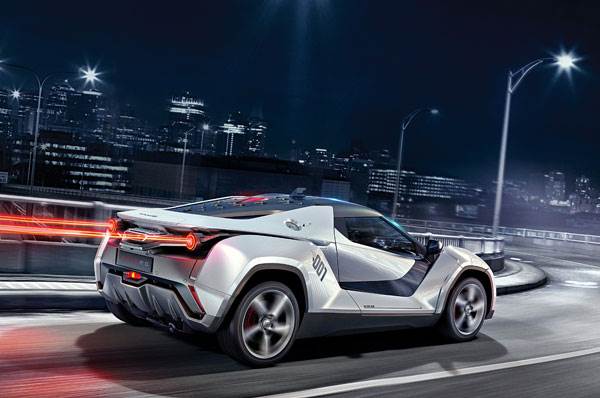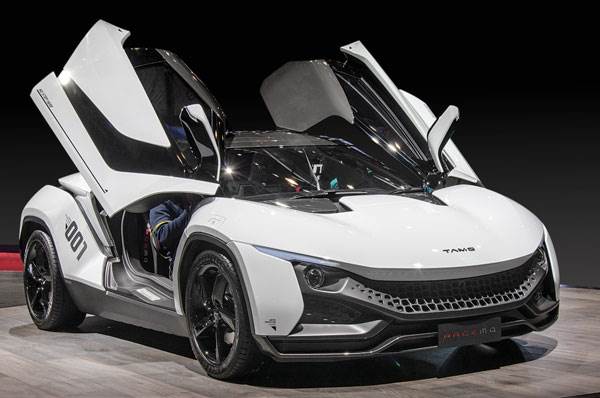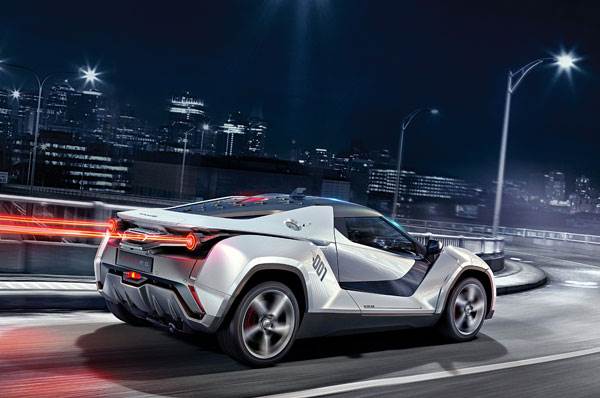We knew about Tata Motors’ secret plan to build a sportscar – known by its project name ‘Futuro’– some months ago. We even had a fair idea of the specs of the car; we knew it was mid-engined and that it was a cracker of a design. But none of this could quite prepare us for what we finally saw.
When the top brass of Tata Motors took the covers off the Racemo, you could hear a collective gasp from the small media group present. It’s not just the shocker of a design but the fact that it comes from Tata Motors – a company better known for trucks, cheap cars and all things unexciting – that makes it hard to get your head around the Racemo. And that’s exactly the perception the manufacturer is desperate to change with the Tamo sub-brand, under which the Racemo has been launched.
A little-known fact is that the Racemo was never meant to become a production reality. It was initially conceived in digital form to target kids between the ages of 12 and 14 who spend most of their free time playing video games. It was a virtual car created for the digital racing world.

A very small team was involved in this ‘skunkworks’ project led out of Tata Motors’ Turin design studio and the brief given was to design a car with no constraints since it was never intended for production. However, the design team went a step beyond and made a physical model which was shown to the top management. Former chairman Cyrus Mistry was so bowled over with the design that he asked a simple question. ‘Is there any reason why we are not making a car like this?’ And thus, with Mistry’s nod, Project Futuro got the green light and the initial budget of Rs 10 crore for the prototype.
The Racemo also fits in with Tata Motors’ new passenger car strategy that kicked off recently. Whilst the mass-volume cars will continue under the Tata badge, the Tamo sub-brand will spawn, low-volume, high-tech cars and the Racemo is the first of the new cutting-edge breed.
Shock and awe
What makes the Racemo unique is its radical construction. Unlike high-volume cars, which are stamped out of steel, the Racemo is built on a patented multi-material sandwich structure coined ‘Moflex’ by Tata Motors. This unique body structure is the brainchild of legendary Italian designer Marcello Gandini who sold the rights to this technology to the Indian manufacturer in 2007.
The Moflex sandwich structure consists of two composite skins with a foam filling injected in between to form an incredibly stiff and light panel. This production method also allows faster readiness for new vehicles. But the big advantage is that it gives great freedom in design and is extremely cost-effective for low volumes. This allows Tata to produce exciting looking cars at an affordable price.
According to Tata Motors, this body construction technology is being used for the first time in the passenger car industry. As if to prove the point that there are no design limitations with the Moflex production technology, the Tata design team has gone to town with the Racemo’s styling. It’s not a clean design like most of Tata’s passenger cars, and instead is a fussy interplay of multiple surfaces and extreme shapes aimed at making heads turn and jaws drop. The wide front grille has a hint of the Tata family look, while the complex-looking rear, with its split and sculpted flying buttresses, seems to have been inspired by the BMW i8. The butterfly doors also add greatly to the wow factor. Wish the headlights didn’t look so ordinary though.
The Racemo’s cabin, with three high-res screens, looks straight out of a video game. The button-festooned steering wheel has large, bright red paddleshifters behind them and the red accents are carried over to the switchgear, the pull straps for the door and the massive air con vents which look like the exhaust of a fighter jet.
.jpg&c=0&w=700)
The Racemo will also feature connected car technologies from Tata’s new partnership with Microsoft. The company hasn’t divulged specific details yet, but says the car will have advanced navigation, predictive maintenance, remote monitoring and over-the-air updates using Microsoft cloud-based technologies. The vehicle owner will interact with these tech bits via the three screens in the instrument area.
On the safety front, the Racemo has disc brakes with ABS and EBD all around. The body is built with integrated crash safety protection with driver and passenger airbags that meet the upcoming Indian regulations. There is a standard three-point seat belt but owners can opt for a safer and racier four-point harness.
The mechanicals of the Racemo bring it down to earth. Whilst it has supercar-like independent double-wishbone suspension all round and a mid-engined layout, the 1.2 turbo-petrol seems a damp squib. Tata claims that this twin-turbo version of its Revotron motor produces 190hp at 6,500rpm but, according to sources, early simulations and tests don’t see it revving beyond 5,500rpm. We are also a touch sceptical about the claimed power output which works out to a potent 159hp/litre. It’s hard to achieve such a high specific output without sophisticated valve timing and direct-injection.
The six-speed Automated Manual Transmission (AMT) is another damp squib. AMTs are best suited to budget cars, but for a sportscar, the shifts are too slow and clunky. However, the Lamborghini Aventador also comes with its own derivative of an AMT and we’ll have to see how Tata has addressed the limitation of this gearbox technology.

Keeping the Racemo connected to the tarmac is the independent double-wishbone suspension with tyres differing in size at the front and rear. The front has 205/50 R17 tubeless radials, while the rear is shod with chunkier 235/45 R18 tubeless radials to match the rear-biased weight distribution of 58:42.
Ride and handling will be fettled by Steve Randall whose boutique chassis development firm also tweaked the dynamics of the Tata Bolt.
This isn’t the first time that Tata Motors has had a crack at the sportscar segment. At the 2000 Geneva motor show, Tata unveiled the Aria concept roadster, which was followed by a coupé version in 2001. However, both did not make it to the production line and the ‘Aria’ name was used for its high-end MPV.
The Racemo, on the other hand, will make it to showrooms. With ingredients of a bona fide sportscar, and the vast resources of Tata Motors backing it, the affordable Racemo could have a ready market abroad as seen by the response at the Geneva motor show.
Tata must now execute the project with both speed and precision, two elements that haven’t been its forte. But now with the creation of the small ‘ring-fenced’ Tamo division, it can operate with an agility that would have been impossible in the mainstream car division. The proof of the pudding will be when the Racemo finally gets into the hands of customers and that could be as early as the end of this financial year. With looks that kill and an estimated price of Rs 25 lakh, the Racemo could not just be the most desirable Tata but the most desirable car for the money.

Also read



.jpg&w=700&c=1)
.jpg&w=700&c=1)


Comments
Member Login
Personal Details
No comments yet. Be the first to comment.